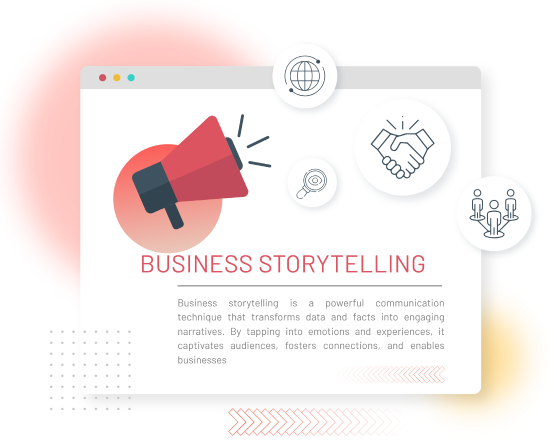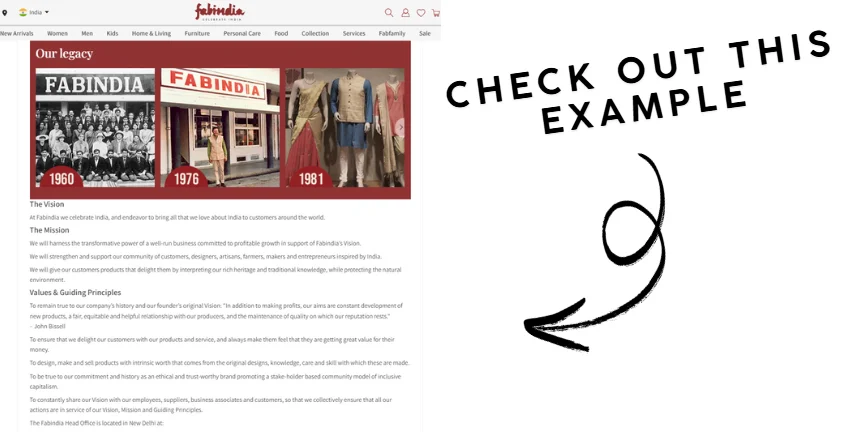
We all have a special story that we enjoy no matter how many times we read it, don’t we? The art of storytelling can grip a reader's heart, emotions, and focus all at once. But why are we talking about storytelling in the business world?
Storytelling isn't just for bedtime or entertainment. It is also used in the business world as an effective way to connect with your audience, convey your brand's message, and inspire customers to make a purchase.
But where do you start? What elements make business storytelling compelling and effective? And how do you craft your own narrative that resonates with your target audience? We have the answers to all your questions.
This blog will be filled with insights and business storytelling examples that will guide you on an exciting journey into the world of business storytelling.
According to Dr. Jennifer Aaker, a behavioral scientist and General Atlantic Professor and Coulter Family Fellow, "Stories are remembered up to 22 times more than facts alone."
Business storytelling involves speaking directly to your target customers' hopes, dreams, and struggles. It can humanize your brand and build a stronger emotional connection with customers.
Stories make a company’s values, mission, and offerings more relatable and memorable, fostering trust and loyalty. By relating stories to customer experiences or challenges, businesses can inspire engagement, differentiate from competitors, and simplify complex information.
Business storytelling grabs attention and creates a lasting impact for customers to envision how the brand fits into their lives. For any business, storytelling is a powerful tool to cultivate a community and drive growth through authentic connections and memorable brand narratives.
Just as a good story relies on important details to maintain interest, business storytelling hinges on a few key components. Whether conveyed through video ads, social media campaigns, content marketing, case studies, or any other medium, these elements are essential for creating engaging narratives that connect with your audience.
In every story, characters play a pivotal role, each driven by their own core values. Similarly, in brand storytelling, your brand takes center stage as a character, embodying its unique set of core values. When you craft your brand’s narrative, these core values determine the stories you choose to tell.
Just as a character abandoning their principles for a quick win can create confusion in a story, your brand should avoid sharing stories that contradict its core beliefs. By consistently sharing stories that reflect your values, you build a narrative that connects with your audience.
This builds trust because your audience sees your brand as someone they can rely on, someone whose actions (products, services, customer interactions) align with their beliefs.
Take LexiConn, for example. Our core value is to deliver clear, engaging, and purpose-driven content. This isn't just a marketing slogan; it shapes how we approach every piece of writing, every SEO strategy, and every client relationship.
Through our storytelling, we share the impact our content has on improving brand visibility and driving results for businesses, all while staying true to what we stand for: high-quality, authentic writing that speaks to people.

In any captivating story, there is a challenge. In business storytelling, this obstacle isn't a fire-breathing dragon but the real pain points of your target audience. Understanding their needs, desires, and frustrations gives you a clear picture of their challenges. These challenges then translate into the hurdles your brand-as-hero needs to overcome.
Focusing on customers, rather than just products, helps you find the right words that make them want to buy. It also helps you see where to add features and products that cater to your customers' needs.
Consider FabIndia, a brand built on the core value of promoting traditional Indian handicrafts and textiles. Their target audience struggles to find high-quality, authentic pieces that fit their modern lifestyle. The narrative positions the hero as the one who bridges the gap by directly addressing the audience's desire for both tradition and modernity.

Every story you write should weave emotions into your narrative in business storytelling. For people to make decisions, they need to feel emotions. Stories tap into emotions, and emotions drive action. Understanding your audience's emotional landscape allows you to evoke the right feelings with your story.
Testimonials and success stories are a great way to capture emotions in a business story. Testimonials are short success stories that connect with your audience on a personal level. Hearing genuine testimonials from real customers about their positive experiences with your brand reinforces your message.
Amul’s emotional connection with its customers is a masterclass in the power of storytelling in business. The story of Amul's inception and its role in the White Revolution fosters a sense of national pride and empowerment, as it highlights the cooperative's success in transforming the dairy industry and uplifting millions of women dairy farmers.

Let’s say you are sitting down to a movie where the characters speak in nothing but scientific jargon and industry slang. You'd be lost with confusing terms, right? The same goes for business storytelling. If your message drowns in complex language and technical jargon, your audience will glaze over faster than you can say "increased ROI."
The main focus of captivating your audience lies in simplicity. Anecdotes are personal stories that humanize your message and make it memorable. Sharing a story about overcoming a challenge can engage your audience and highlight key points like determination.
Pop culture references, on the other hand, can simplify complex ideas and make your message stick. Referencing a popular TV show like "Game of Thrones" to explain adaptability makes the concept relatable. Combining anecdotes and pop culture references ensures your storytelling connects, keeping your audience engaged and your message clear. See how Naturals Ice Cream portrayed their story so well:

Every narrative should have a transformative power that inspires change. Just as audiences are moved by movies or literature, businesses aim to wield the same influence through compelling storytelling. The essence lies in captivating the audience and empowering them to take meaningful action.
The main goal of business storytelling is to help the audience make a meaningful move forward, like buying a product or asking for a service. It's a chance for them to take control and start a new journey that’s all their own.
The Donald Miller Framework, also known as the StoryBrand Framework, is a marketing approach developed by Donald Miller. It helps businesses clarify their messaging. It centers around the concept of storytelling, where the customer is the hero and the business is the guide who helps them overcome challenges and achieve success. This brand storytelling template consists of seven key components:

The customer is the hero, not your company. For a brand, it's crucial to grasp what customers desire and demonstrate your ability to fulfill those needs. Initially, concentrate on a single, distinct offering, avoiding the pitfall of spreading your focus too thin. As customers engage with your brand, gradually introduce additional products or services, ensuring a clear and coherent message without overwhelming them.
For a brand storytelling example, if an aspiring photographer wants to capture stunning landscapes but struggles to find the right camera equipment, a photography brand can step in by offering a high-quality camera lens. If the photographer engages with the brand and sees the benefits of the lens, the brand can then introduce other accessories, sharing a clear message without overwhelming them.
To captivate your audience through brand storytelling, focus on addressing problems that deeply connect with them. Just like in movies, where villains symbolize obstacles, in business storytelling, the 'villain' represents the challenges customers encounter. This villain must be identifiable, singular, real, and the root source of frustration. There are three types of problems the customer can face.
A successful brand addresses all these layers of problems in its proposition. Businesses can craft compelling narratives that drive engagement by identifying and addressing these villains and associated problems.
Customers seek guidance rather than another hero. Just as in movies, where heroes rely on mentors, businesses should position themselves as guides, with customers as the heroes. The focus should always be on aiding the customer's success, not on the company itself.
In narratives, heroes often face doubts and challenges, while guides possess authority yet remain in the background. Likewise, in business, being acknowledged as the guide necessitates demonstrating empathy and authority without appearing overbearing. Providing evidence of competence through testimonials, statistics, awards, and endorsements from other companies is crucial.
Customers place trust in a guide who offers a clear plan. Just as characters in stories receive specific strategies to navigate challenges, businesses must articulate how to engage with them or mitigate associated risks. Plans typically take two forms:
By addressing customer concerns and delineating actionable steps, businesses can cultivate trust and confidence in their guidance.
As a business storytelling example, let’s consider a homeowner looking to remodel their kitchen and seek guidance from a renovation company. The company provides a process plan detailing each step of the renovation process, from initial consultation to final inspection. Additionally, they offer an agreement plan addressing concerns about budgeting, timelines, and quality assurance, ensuring transparency and building confidence with the homeowner.
Customers are more likely to take action when faced with a challenge. Similar to how heroes in stories are driven to act by external circumstances, like a kidnap, simply deciding to act on their own is less motivating.
Therefore, businesses need to encourage customers to take action by persuasive techniques to encourage immediate action, such as limited-time offers, exclusive deals, or bonuses for early adopters. This interaction kickstarts a relationship that can ultimately lead to a sale.
Just like how audiences are kept in suspense in movies until the hero's success is revealed, businesses should explain what might go wrong if you don't buy their product or service. But they shouldn't talk about it too much, or it might scare people away.
As a business storytelling example, let’s consider a skincare brand that can discuss the potential outcomes of neglecting skincare, such as premature aging, skin damage, or acne breakouts.
Businesses need to clearly explain how their product or service will improve customers' lives. This can happen in three main ways:
Consider a language learning app that emphasizes how it can improve customers' lives by providing users with the opportunity to gain new skills and a better social position. The app enables them to learn a new language like Spanish or French, opening doors for career advancement, travel experiences, and personal growth.
As the curtain falls on each chapter of their story, businesses find themselves not just as sellers, but as storytellers shaping the narratives of countless lives.
When a business tells a story, it aims to convey something meaningful: a message, emotion, or vision. The goal is to make customers feel like they're part of something larger. Remember, customers see themselves as heroes in their own stories.
Simply presenting what you have to offer isn't enough; they want to understand how your product makes them special. Whether you're a large corporation or a small business, never overlook the impact of storytelling. It's more than just sales—it's about inspiring, forging connections, and leaving a positive impact on people's lives.
Every word holds the potential to resonate with your audience deeply. At LexiConn, we take pride in our expertise in crafting narratives that transcend mere sales pitches. Our focus is on fostering genuine connections and leaving a lasting impact through storytelling. Take the first step today and try our pilot program to embark on a storytelling journey that will redefine how your brand is perceived in the world.
Feel free to visit us at www.lexiconn.in or contact us at [email protected]. LexiConn also provides a complimentary 30-minute content consultation session to assist with your content strategy.



I have read and accept the Privacy Policy
Read More